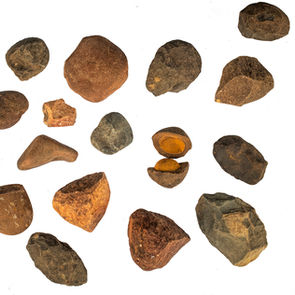
Local Aboriginal Artifacts - STONE TOOLS
"They are everywhere," according to a geologist I met recently. "You just have to look." Since hearing this I've started scanning the ground when I'm out on my bush walks, (rather than with my head in the trees looking for birds). If I found a simple stone tool, a material link with original custodians, I would be over the moon. I have learned that Aboriginal descendants believe the artifacts should not be disturbed, in fact it is illegal to remove them. They should be left in situ, and if it was necessary to remove them (as was the case in the Millmerran Mines project), the location should be recorded so they may be returned to country when possible. Fortunately, some farmers have saved what they could before the bulldozers and ploughs buried these treasures forever, and I hope our understanding of the customs of this extraordinary culture has been enriched when we see these items. When you hear stories of a well-known Bora Ring being ploughed in, for example, there is a sense of enormous loss for everyone.
When I met local farmer Ken Stower and he told me about the many Aboriginal stones that he had picked up on his property, I couldn't wait to head out to Bora Creek Road to see this collection. To me, Ken has a natural respect, not only for the artifacts of the original caretakers of the West Ridge area where he has farmed for decades, but the flora and fauna in the forested hills which surround him: Koalas, Wedgetails, Parrots, native Orchids, he values them all. He is aware of some culturally significant landmarks on and near his property, which I will be exploring in the near future: a tool making site, a tree with scarring that was used for testing axes.

Keen visitors, from researching academics and indigenous friends, have visited Ken's property, and enlightened him about the practical application of the tools he has picked up: The large oval stones being used to work the kangaroo hides (Figure 4), by pulling them over and over and rubbing on the surface to soften and smooth the skins; The flat stone with a sharpened edge which fits snuggly in the palm of the hand, being used as a scrub tick remover (Figure 5); the grinding stone which would have pulverised the Aboriginal medical plant Gumbi Gumbi which grows nearby. (Figure 1).
Click on images below to enlarge
The first image is of a Grinding Stone found on Ken and Cathy's property west of Millmerran measuring 23.4cm x 16.2cm. The lower platform with a deep indentation is called a Millstone. The smaller stone used as the grinding tool is called a Muller. They are the largest stone implement in the Aboriginal stone tool kit and used primarily by the women (and young girls) for grinding seeds from grasses, trees, shrubs, succulents and ferns to release the starch for bread making. Animal bone was cracked here for the extraction of marrow, cartilage and small animals such as lizards were pulverised. The grinding stone also used for preparing pigments such as ochres, resin and bush tobacco, and to sharpen and smooth wooden and stone tools.
The heavy Grinding Stones were left at the Camp site, placed upside down to stop erosion from rain and wind, and used again and again when the group returned to the area. However, it is known that the smaller Mullers were carried between sites. Grinding stones have been used for thousands of years, some dating back 30,000 years. One wonders how old this one is, and how many generations could possibly had used it.





